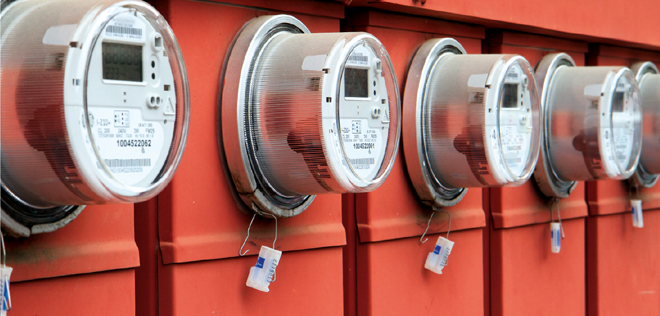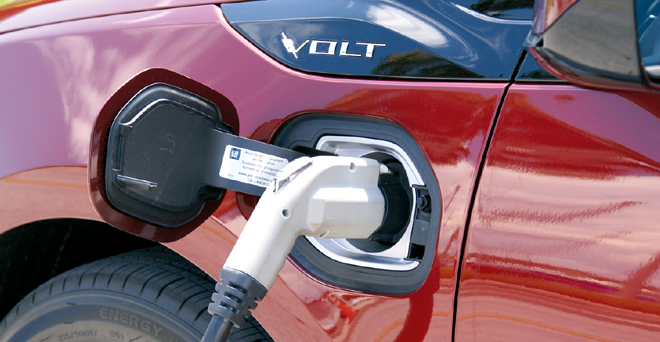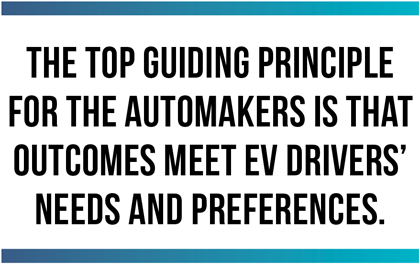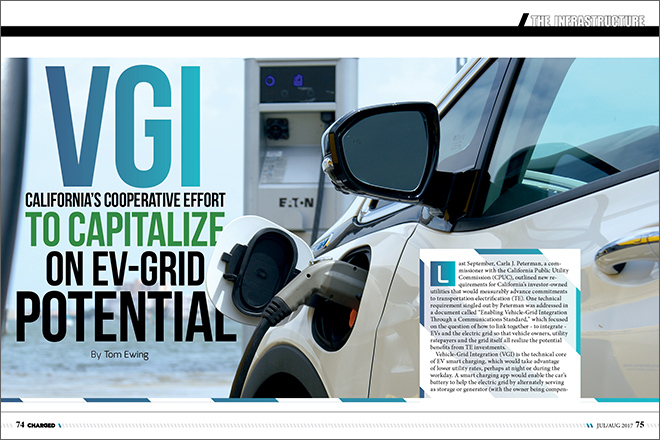Last September, Carla J. Peterman, a commissioner with the California Public Utility Commission (CPUC), outlined new requirements for California’s investor-owned utilities that would measurably advance commitments to transportation electrification (TE). One technical requirement singled out by Peterman was addressed in a document called “Enabling Vehicle-Grid Integration Through a Communications Standard,” which focused on the question of how to link together – to integrate – EVs and the electric grid so that vehicle owners, utility ratepayers and the grid itself all realize the potential benefits from TE investments.
Vehicle-Grid Integration (VGI) is the technical core of EV smart charging, which would take advantage of lower utility rates, perhaps at night or during the workday. A smart charging app would enable the car’s battery to help the electric grid by alternately serving as storage or generator (with the owner being compensated) and having the battery ready to go at, say, 7:00 am, sufficiently charged for the day’s travel.
Obviously, this is complex science. To realize the full system-wide benefits, there will need to be commonly accepted standards and practices for hardware, software, security and communication, among all participants, some of whom are otherwise direct competitors – automakers, for example – and might work very hard to keep electronic advantages proprietary.

In her ruling, Peterman noted that, as policy, VGI is not a wish-list item. Rather, it is required by Governor Brown’s Executive Order B-16-2012, which directs that “electric vehicle charging will be integrated into the electricity grid” by 2020. VGI is one of the demands within the State’s zero-emission vehicle (ZEV) directive. In other words, this has to work. Peterman writes that “the accelerated development of the electric transportation market at scale necessary to reduce climate change and air pollution will rely on harnessing technologies that enhance the capability of vehicles to establish communications with a variety of devices and entities, both proximal and distant, for many use cases.”
In response to Peterman’s focus on VGI, California’s major investor-owned utilities suggested that the next steps would benefit from a new public working group. The California Public Utilities Commission (CPUC) supported that suggestion, and the Vehicle-Grid Integration Communications Protocol Working Group was established in April, a cooperative effort among many state agencies, including the CPUC, the California Energy Commission and the California Air Resources Board (CARB).
The Working Group includes many public members. Several automakers are active participants, including Honda, BMW, Fiat Chrysler, Ford, Nissan, Tesla and Toyota. There is also a separate, smaller group established to provide technical comments and insight. This smaller group, called the OEM Group, is led by Richard Sholer, Manager, Vehicle-to-Grid for Fiat Chrysler.

The Working Group has an ambitious work plan and schedule – it hopes to finish its work in October, and send its recommendations to the CPUC. Then, likely in the spring of 2018, the CPUC will decide the merits of specific utility investments (including what to fund and where). These will be “go/no go” decisions as they pertain to proposals with the utilities’ TE filings, submitted last January 2017.

July is about the mid-point of the Working Group’s schedule. For an observer, progress is hard to judge. This is a devilishly difficult subject and, understandably, participants have spent a lot of time reviewing and challenging work directions, definitions and the scope of the Working Group. Important concepts still need common ground.
Consider “definitions,” for example, which has its own sub-group. In June, the list of definitions was 27 pages long, with 60 new terms recently added. There are, for example, eight potential ways to define “capacity.” A technically based communication standard, however, demands precision, especially when dealing with questions of value, money, safety, security and apportioning that value and responsibility among many players – vehicle owners, ratepayers, building owners, employers, utilities and generators.
Another difficult, but central, topic centers around the analysis of what are called “use cases.” These are descriptive outlines that start with relatively simple and basic EV charging situations but become increasingly complex as possibilities and opportunities expand. An analysis may start with one car plugged into one charging unit with power flowing just one way from just one utility. With this “use case,” benefits are relatively easy to define: the EV owner buys power, the utility sells power with no middleman, and the transaction clears the market.

But consider much more advanced use cases. Let’s say 10,000 vehicles are controlled by a third-party power aggregator. The vehicles are not in the same location – they could even be in different cities. Connections, at various times, could include multiple utilities. Power could flow both ways, benefitting a range of generators, transmission operators and ratepayers. Importantly, the participants may not be prompted by what CPUC staff refer to as “unified actor objectives,” i.e., people have different expectations and interests. With these complex use cases, how should costs and benefits be measured and distributed among EV owners, aggregators, grid operators, utilities, and energy management centers in buildings?
The “use case” sub-group has dominated recent agendas. At the end of June, 30 “use case” reviews had been finished, and 21 more were coming up. It’s a slow, hard process, done by volunteers. End points are hard to determine. Possible next steps, for example, include establishing a new sub-group to map the use case requirements to communication protocols.

A frequent concern at the Working Group meetings is whether EV customers are being properly kept in mind. After all, EVs are not being developed and promoted for energy officials to use as granular parts of the electric grid, plugging and unplugging in timely ways to help offset intermittent solar and wind generation. That’s nice, but people buy a car to move around (after all, this is California) and green enthusiasm will sour quickly if huge bots essentially tell people they can drive only after a remote grid is judged to be in balance.
The top guiding principle for the automakers is that outcomes meet EV drivers’ needs and preferences, specifically regarding a “driver’s mobility, need for simplicity, and that privacy is preeminent and that a vehicle’s charging behavior is consistent with the battery management system and mobility requirements are not externally curtailed by an entity without consulting the driver.”

Another concern is that more delays regarding VGI policies will slow EV demand. Potential customers may wait until these uncertainties are settled. Buyers may shrug their shoulders and return to what’s familiar: an internal combustion vehicle. That’s not the kind of momentum needed to help the EV market flourish, and help California meet its statutory requirements regarding ZEVs, energy and climate change.
Considering VGI’s complexities, Richard Sholer was asked whether VGI technology is ready to go, whether theory can be put into practice today. Sholer said, “Yes, we’ve been creating the standards for the last 10 years.” He noted that there are utility standards, electrical engineering standards and OEM standards, all demonstrated to work. “It’s ready to go,” he said.
Then, what’s the hold-up? Sholer said the automakers are “looking to the CPUC and the Energy Commission to understand any value proposition, because there’s still the cost of implementing communication in a home or in a fleet or a public [charging] location.” There remains a basic question: “What’s the value to the customer?”
Another concern for the automakers is a common one regarding public policy, technology and the future. Technology – particularly communications technology – changes so fast that there are dangers in setting goals and looking for outcomes, with prescriptive directives based on today’s hardware and software. Jeremy Whaling, Grid Connected Project Manager for Honda, presented these concerns on behalf of the automakers and the utilities at the June 26 meeting. Whaling and his group use the phrase “future-proofing” to describe the direction in which VGI should move. Future-proofing is defined as “minimizing risk, not market development or defining VGI value.” Future-proofing should not limit or impede innovation.
This becomes difficult territory for policy makers. Recall that VGI is not a wish-list item – it has to work, it has to be part of transportation electrification in California. Recall Commissioner Peterman’s comment that the benefits of an EV market at scale will rely on vehicle-grid communication. That’s the hard part: making choices today that will remain reliable and viable in a field that seems to change overnight.
This article originally appeared in Charged Issue 32 – July/August 2017 – Subscribe now.










































































































